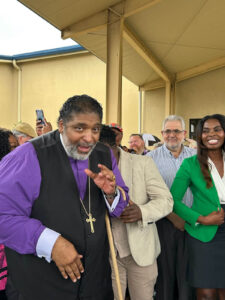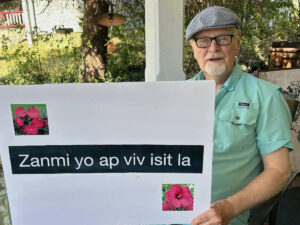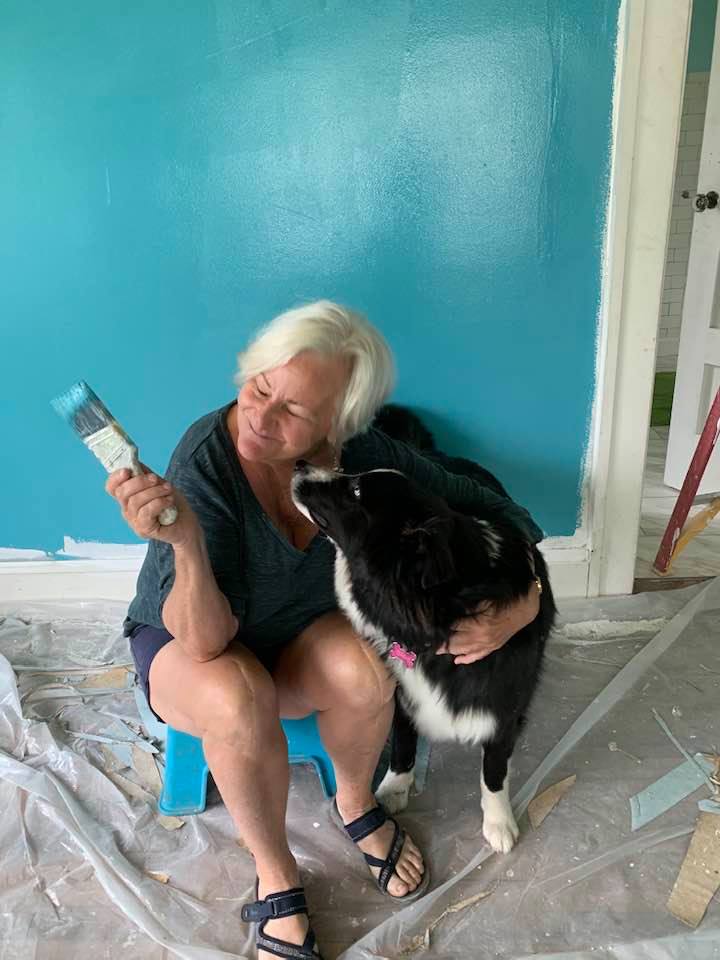A letter from Springfield
A racist lie goes viral, and a small Midwestern city pushes back
A racist lie goes viral, and a small Midwestern city pushes back
The outlandish story about illegal Haitian immigrants kidnapping and eating their neighbors’ pets in Springfield, Ohio, was a textbook example of what happens when a weird rumor morphs into unchecked hate speech. For someone like me who teaches journalism, the story was a gold-plated, teachable moment. There it was, in all its glistening, viral ugliness. But I live in Springfield, and the lesson was embarrassing, infuriating, with a life of its own.
“In Springfield, they’re eating the dogs, the people that came in,” Trump said during the presidential debate with Vice President Kamala Harris. “They’re eating the cats.”
“The people”—as everyone knows by now—were the Haitians living in Springfield, the ones who left the political oppression and violence in their own county, only to encounter it here, in the heartland of America.
There are many Springfields in this country, nearly three dozen. This particular one is mine. I claim it. After a peripatetic childhood, and years of geographic upheaval, leaping from job to job (Los Angeles County, San Francisco, Marin County, Colorado Springs), I landed in Springfield, where I’ve lived for 20 years. I never expected to become an apologist for this small blue-collar city. We’ve been on the front page for weeks, thanks to Trump, and I feel compelled to speak on Springfield’s behalf.
The city is many things—flawed, resilient, charming, unpretentious, and yes, going through an identity crisis. As recently as 1983, Newsweek magazine named Springfield one of America’s “dream cities.” There was little crime, a university, racial harmony (the city was the first major U.S. community to elect a black mayor), a vibrant downtown, still active industries and a central location on the region’s road and rail networks.
But a few years later, the population began to spiral downward, suffering from “brain drain” as the good-paying jobs dried up and young people moved elsewhere. In 1960 there were 82,000 people in Springfield; today, the population is about 58,000.
In the last few years, however, the city has been making a comeback. There’s been a resurgence in manufacturing and warehouse jobs. This new boom has attracted a large influx of Haitians who’ve come because of jobs and affordable housing. Since the pandemic, city officials say there are an estimated 12,000 to 15,000 Haitians now living in Springfield and surrounding Clark County. As they’ve come in, they’ve been good neighbors filling jobs, raising wages, paying income taxes, fixing up dilapidated houses and increasing property values. They’re helping the city wake up again. There’s a buzz downtown. The landscape is changing: new restaurants, a brewery, large-scale public art, cafes and galleries.
But the newcomers are stealing and eating dogs and cats, even swiping wildlife from the parks, right? No, false. Still, as soon as that story hit the internet, Springfield became the center of the charged political debate over immigration. And the memes, well, they just kept coming. The pet-eating story even made an appearance on The Simpsons.
“People are eating dogs?” said a puzzled Clancy Wiggum, chief of police. “People are eating dogs and cats in Springfield?” (A long beat.) “Are they good?”
We chewed over the Haitians-eating-pets story in my Intro. to Journalism class at Wittenberg University, a small, liberal arts institution in Springfield where I work part-time. The students in my class from Springfield were angry and defensive. Their home was the punchline to a mean-spirited, humiliating joke. And it wouldn’t die, even though the lie had been debunked; in fact, it continued to spawn more offspring of its own. How did such a rumor get started?
One student opened up her computer and turned to a Facebook page. There it was, a third-hand account of a missing cat, an animal allegedly found dead outside a Haitian family’s home. Or so the story went. Later, we learned the genesis started when a Springfield woman called the police back in August, fearing her missing cat had been nabbed and eaten by her Haitian neighbors. A few days later, Miss Sassy reappeared. She’d just been down in the basement.
*****
“If your mother says she loves you, check it out.” That’s one of the first rules of journalism. Verify the facts, even the ones that must be true. Double-check all sources. Here were the facts: No pets had been stolen and eaten. Misinformation, a hunch, an unfounded fear repeated on social media—all dispelled. But now Springfield was in the spotlight, a metaphor for America’s fight over immigration. Day after day, our city was front page news, and it wasn’t about dogs and cats anymore. It was about resentment, racism, the economy and belonging.
In a city where there’s a 22 percent poverty rate, and where the median income is just over $27,000, the newcomers were straining the social safety net. Housing costs were spiraling out of control, rents were being jacked up by greedy landlords and immigrants were taking jobs, local immigration opponents protested.
Anger against the Haitians came to a head 13 months ago when a Haitian man driving a minivan swerved into oncoming traffic, accidentally killing Aiden Clark, an 11-year-old boy, and injuring 23 other children. Furious residents showed up at city hall, demanding that something be done. Were the immigrants here legally? Did they have diseases? Why, exactly, were they here? They were bad for Springfield. They broke laws, they couldn’t speak English, they were dangerous behind the wheel and they were living off the fat of the land through government subsidies. It wasn’t fair.
Last month was the one-year anniversary of Aiden Clark’s death. National stories marked what happened with segments on TV about Springfield’s Haitians and the economic picture. On the PBS News Hour, Jamie McGregor, CEO of McGregor Metal Co., talked about how the Haitians who worked for him were such dependable employees. (McGregor, a life-long Republican, has received death threats since the story aired, according to the New York Times. Now he has a gun to protect his family.)
After the presidential debate, bomb threats were sent to hospitals, government buildings and schools. The university where I teach closed for a week after a barrage of threats forced classes to be taught virtually. Neo-Nazis and other hate groups like the Proud Boys have marched through town wearing ski masks and carrying swastika flags. It’s unreal.
When Vivek Ramaswamy came to Springfield for a “town meeting” two weeks ago, a big crowd showed up and spilled onto the streets. There was a dangerous anything-goes spirit in the air, as if something could happen at any moment. Walking downtown that night, I passed a man carrying a rifle over his shoulder.
Life as we knew it was being erased. The city’s upcoming Culturefest, which celebrates diverse art, food, and culture, was cancelled. Observation towers were erected at key points around town and state troopers were strategically stationed at schools and city buildings. Even now, weeks after the debate, I feel braced, waiting for the other shoe to fall.
At last week’s Springfield City Commission meeting, upset residents vented their anger, frustration and bewilderment about the Haitians. It was distressing to watch. Some were upset about the way the city was depicted in the national media, as a narrow, unfriendly place where strangers weren’t welcome. “I’m not racist, I’m not xenophobic,” one woman told the commissioners. Others blamed local government officials for not stepping in sooner, asking for help from the state. “It shouldn’t have taken you all so long and a presidential debate to ask for the help this city needed,” one man said. “That’s your guys’ fault.”
Another man said, “Haitians are trying to act like African Americans born and raised here. They’re not Black Americans. And I want to know—why are these people being coddled and pampered and given a beautiful life, a life better off than the one I live? They’re getting the special—the red carpet treatment, man. This is wrong. We’ve become second-class citizens.”
*****
On Saturday night, a neo-Nazi group called the Blood Tribe stood on the sidewalk in front of the mayor’s house. They were dressed in their trademark red shirts, black pants and black ski-masks, and they were carrying swastika flags. No violence erupted, but the message was clear. We’re here and we know where you live. We’ve got you in our sights.
Lately, there’s been a police car parked in front of the church I attend, Central Christian Church, where Carl Ruby is the senior pastor. I started attending Central about a year ago because I liked Ruby’s welcoming attitude toward the Haitians. His stance toward salvation is not “I’m-saved-and-going-to-heaven,” as he likes to say, but has a more immediate emphasis on the moral traditions of faith, love and justice. In other words, all this and heaven, too. I’m not sure about Gloryland, but I agree with Ruby. We’re commanded to welcome the newcomers in our midst. And it’s the right thing to do. “God loves the immigrant and so should we,” Ruby exhorts.
For many of us, that core question—who is your neighbor?—gets to the heart of the immigration debate. As an Army brat who frequently moved every two or three years during childhood, I was keenly aware of what it felt like to be a newcomer, someone on the outside. It’s lonely until the circle opens up and there’s room for you.
I asked my journalism students to think about how they saw themselves. Did they see themselves first as citizens of the United States or as citizens of the world? We talked about curiosity and empathy, whether the glass was half-full or half-empty. That attitude—determining who was “us” and who was “them”—would affect how they framed their stories.
The Haitian families who fled gang violence and shootings are trying to start over here. Some of them are afraid to leave their homes now—or send their kids to school.
Last week at church, Ruby acknowledged that his pro-immigrant stance was hard for some members to swallow. He recalled a male parishioner confronting him, saying, “Carl, you taught me to love my neighbor. Springfield is my neighbor. Haiti is not my neighbor.” The man left Central Christian.
*****

William J. Barber II in Springfield, Ohio
In journalism, the time-honored way to write a breaking news story is using a formula called the Inverted Pyramid—leading with the most important information first. Crucial questions must be answered right away. Is everyone OK? How bad is it? What’s the context?
That depends, of course, on who you talk to. A few of the Haitians who moved here are thinking about leaving. They’ve come from a country of tragedy and misfortune and danger, and now it’s happening to them all over again, here in Springfield. This is not what they bargained for. Springfield is dangerous and chaotic.
But if there is anything good to come out of this humiliating and frightening time in Springfield, it’s that people here are waking up.
Some who have lived here for years are showing their solidarity. They’re spending their money at the new Haitian restaurants in town, tutoring Haitians in English on weekends, even handing out little cards to them that say: “I’m glad you’re here. Christ loves you and so do I.”
Two weeks ago, at what was being called a “prayer-worship-rally-vigil,” a large crowd stood outside Greater Grace Temple in Springfield listening as civil rights activist William J. Barber II rebuked JD Vance and Donald Trump for perpetuating “a season of lies.”
“Stop beating up on the immigrants and let’s get down to the real issues,” said Barber, founding director of the Center for Public Theology & Public Policy at Yale Divinity School. Nods and “amens” and “preach” rippled through the crowd as he spoke. The vitriol over America’s immigration policy only underscored deeper problems in the U.S.—poverty and the lack of a living wage, he said, then led the crowd in a loud call-and-response chant, praying that the lies and hatred would end. Each time he said the violence must cease, those in the crowd replied in agreement, “Stop it!” Over and over again, they said it. Loudly. Stop it. Just stop it.
Springfield’s growing pains are painful and public. The Springfield City Commission meetings continue to offer a front row seat on the drama this place is going through: outsiders joining the circle, resentful people pushing back, the scramble for resources, the sorting out of who deserves to belong. Rejection. Assimilation.
One man at the last commissioner’s meeting named Charlie—I didn’t get his last name—had these words of encouragement: “This is for my Haitian friends: don’t let anybody’s hate, ignorance, drama or negativity stop you from being the best person you can be. Some people are waiting to see you fail, some people are waiting to see you quit. Let them wait forever.”
*****
In Springfield, the headlines keep changing, but the inverted pyramid formula holds, the questions remain: Is everyone OK? How bad is it? What’s the context?
I’m not OK. The mood in Springfield is tense. Something uneasy is bubbling beneath the surface. In the middle of the night, sometimes I worry if the signs in my front yard welcoming Haitians will be stolen. Will my neighbors’ children be OK? What about the Haitian family that lives around the corner? Are they safe? If neo-Nazis march down my street, will things escalate? What then? Should I move?
Then I remember how one Springfield man, Nick Mastick, made a homemade sign and posted it on the wrought-iron fence in front of his house. “Zanmi yo ap viv isit la” it said in Haitian Creole. “Friends live here.”
I am one of them. I’m not going anywhere.

Nick Mastick of Springfield, Ohio
D’Arcy Fallon, an award-winning former Colorado Springs Gazette reporter, lives in Springfield, Ohio. A professor emerita of Wittenberg University, she is the author of a memoir, So Late, So Soon (Hawthorne Books), about living in a religious commune in the ‘70s. Her work appears at https://darcyfallon.substack.com.
Click here for more from D'Arcy Fallon.
